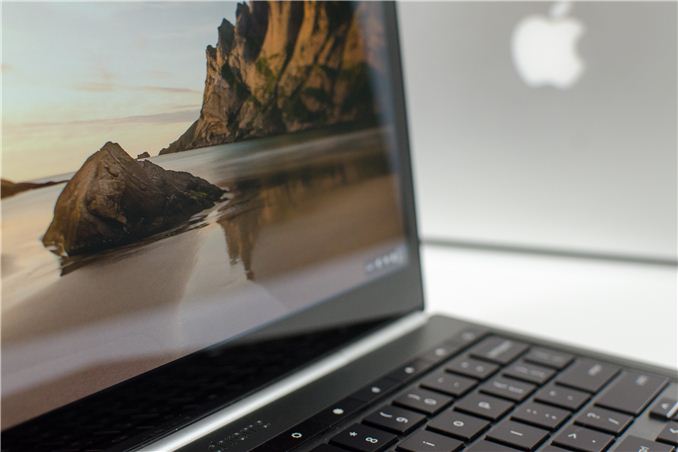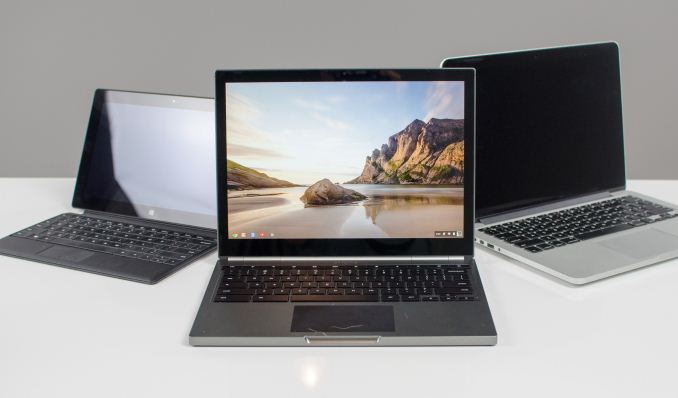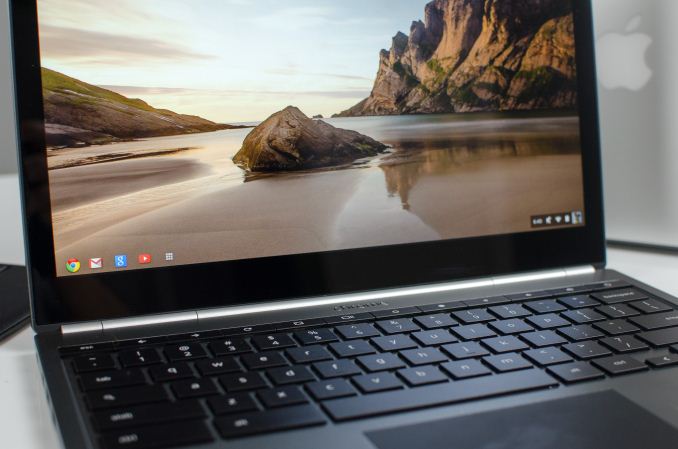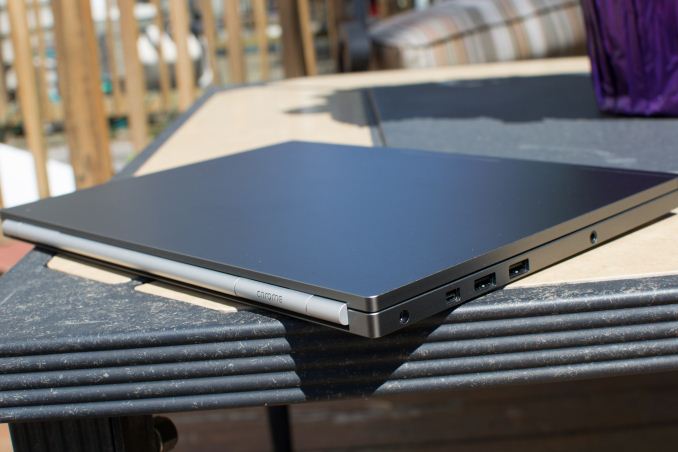The Chromebook Pixel Review
by Jason Inofuentes on May 31, 2013 8:00 AM EST
Context
Nothing exists in a vacuum, certainly not any of the products we review. The context of our subjects has a lot to do with what’s expressed in our reviews, even in the stark light of data. Scores alone are never enough, we juxtapose the latest widget to hit our bench against its most likely competition, against its predecessors, and against anything else that might make sense. We think about the era in technology, the trends that pervade the market, and where they’ll take us in the coming months and years. We ask what the market’s demands are, and where they’re going to be later, and discuss how the subject handles those present and future demands. That’s no different here, but we could almost imagine foregoing the Pixel’s context and telling its tale absent its past, so disparate it seems from the Chromebooks that came before. But then we’d miss some of the most interesting bits.
The PC market has been in decline for sometime. There’s an argument to be made that the move to mobile has negated the need for a proper personal computer, and yet, it remains the exception to hear that someone has rid themselves of all their desktops and laptops and lives and works entirely on tablets and smartphones. That day might be ahead, but for now, few are the power users that manage to work and write on their iPads; and most of them have a keyboard dock tucked in their bags somewhere. For most the tablet remains a consumption device; less cumbersome than a laptop for reading, web browsing and watching video. Tablets are the future, though, right? Microsoft seems to think so. Apple has certainly made its case. So with the PC preparing its swan song, what would compel Google to chime in with a stripped out operating system that consists almost entirely of a browser that can be run on any of the current platforms?
There’s a different argument that can be made about the PC’s decline. The operating theory when purchasing a computer was always to buy more hardware than you presently needed, so three or four years down the road your computer was still useful. Software advances outpaced hardware, and so an early Pentium II with just a few megabyte’s of RAM that ran Windows 98 just fine in 1998 didn’t do well with Windows XP just a few years later. Intel’s Core processors changed all of that. A Dell E1505 (my own, in fact) specced with the first Intel Core Duo processor handles Windows 8 just fine. Though they served no one terribly well, netbooks popularized the idea that most users needs could be (somewhat) met by even modest hardware. Intel’s Ultrabook initiative drove the price of lightweight but well performing laptops down under $1,000 and even further still. And still for most users, the modest performance of a ULV processor is more power than they really need to consume media, edit documents and click away in a browser.
Google’s first round of Chromebooks were netbook slow. The stripped down experience was better than stuffing Windows into those tight confines and running Chrome atop that, but the applause ends there. The next generation added incremental performance increases, but was just as mired in performance that didn’t quite reach that “just enough” threshold. The most recent models, the Acer C7 and the Samsung Chromebook (XE303) were stark departures in price and performance, with the Samsung model even adding a hint of style. We liked those models, and praised their almost disposable pricing. These models represented a great ground floor for Chromebooks, just enough performance, and pricing that reflects that. I think we expected to see variations of these models iterate into the future, with performance improving each year. We could even see a path where more and more users would choose Chromebooks in lieu of other second machines, we could see these being successful with the right crowd. I don’t think any of us expected this.
Design and Specifications
The Chromebook Pixel is a well cut suit. I’m cribbing the metaphor, but that’s exactly what the design of the Pixel evokes. The lines are simple, but elegant. The color would look great over a plain white shirt, and, perhaps, an orange silk necktie. The austerity of the design, actually lends the Pixel an outsized feel. This is after all a small notebook, fitting within the profile of the 13" MacBook Air. Put it out of context, though, and the aluminum surfaces seem to go on for ages. Only when you wrap your hand around an edge that you realize it's so small, so thin.
| Chromebook Pixel Comparison | ||||||
| Chromebook Pixel | 13-inch MacBook Pro with Retina Display | 13-inch MacBook Pro | 13-inch MacBook Air | |||
| Dimensions | 0.64 x 11.72 x 8.84" | 0.75 x 12.35 x 8.62" | 0.95 x 12.78 x 8.94" | 0.11 - 0.68 x 12.8 x 8.94" | ||
| Weight | 3.35 lbs (1.52 kg) | 3.57 lbs (1.62 kg) | 4.5 lbs (2.06 kg) | 2.96 lbs (1.35 kg) | ||
| CPU | Core i5-3337U | Core i5-3210M | Core i5-3210M | Core i5-3427U | ||
| CPU Cores/Threads | 2/4 | 2/4 | 2/4 | 2/4 | ||
| L3 Cache | 3MB | 3MB | 3MB | 3MB | ||
| Base CPU Clock | 1.8GHz | 2.5GHz | 2.5GHz | 1.8GHz | ||
| Max CPU Turbo | 2.7GHz | 3.1GHz | 3.1GHz | 2.8GHz | ||
| GPU | Intel HD 4000 | Intel HD 4000 | Intel HD 4000 | Intel HD 4000 | ||
| System Memory | 4GB DDR3L-1600 | 8GB DDR3L-1600 | 4GB DDR3-1600 | 4GB DDR3L-1600 | ||
| Primary Storage | 64GB iSSD | 128GB SSD | 500GB 5400RPM HDD | 128GB SSD | ||
| Optical Drive | N | N | Y | N | ||
| Display Size | 12.85-inches | 13.3-inches | 13.3-inches | 13.3-inches | ||
| Display Resolution | 2560 x 1700 | 2560 x 1600 | 1280 x 800 | 1400 x 900 | ||
| DisplayPort/Thunderbolt Ports | 1 | 2 | 1 | 1 | ||
| USB Ports | 2 x USB 2.0 | 2 x USB 3.0 | 2 x USB 3.0 | 2 x USB 3.0 | ||
| Other Ports | SD reader, headphone out, SIM slot | SDXC reader, HDMI out, headphone out | GigE, FireWire 800, SDXC reader, headphone out | SDXC reader, headphone out | ||
| Battery Capacity | 59 Wh | 74 Wh | 63.5 Wh | 50 Wh | ||
| Price | $1449 | $1499 | $1199 |
$1199 |
||
The back, we’ve mentioned, is filled with that long silver hinge. On the left side are two USB ports, one DisplayPort, and the power and headphone/microphone port, which remarkably are cut to be the same size, with black trim filling out the microphone port. That detail is indicative of the time and attention paid to even the smallest components. On the right is the SD card slot, and the SIM tray on the higher SKU. The front is bare but for the indentation for opening the lid. The bottom is a large plain panel, with small rubber feet at the far corners, and the necessary labels and whatnot.
The Chromebook Pixel is gorgeous to the understated crowd. Not flashy, not cheap. As alluring as Cupertino’s finest designs. The flashiest part of the design isn’t that gorgeous display; it’s the light show going on when the lid is up. If I ever saw one in the wild, I could imagine the pulsing blues, greens and reds would catch my eye quickly. I’d want to know what it is, who makes it, where I can get it. If you didn’t know the company behind ‘chrome’ you’d have few clues from just looking at the design. That is until the lid is closed and the LEDs pulse briefly with Google livery. It is gorgeous, it has a super dense display, is stuffed with great technology, starts at $1299... and it’s running a browser.
I’m not going to lie, I was excited about this product the moment I saw that cheesy leaked video a few weeks before the announcement. At the time, I hoped it was still several months away from release, with plans to build it on Intel’s Haswell SoC or a quad-core ARM Cortex-A15 SoC. I also hoped it would be priced competitively with Ultrabooks, somewhere north of $500 but under $1000. In a way, I still wish all those things were true.
Comparing spec sheets the Pixel falls in a weird place. The dual-core Ivy Bridge is a little on the light side, with a base clock of just 1.8 GHz and a max turbo clock of 2.7 GHz, this 17 W part is similar to what you’d find in the 13” MacBook Air but just behind what you’d find in a lot of current Ultrabooks. The display is unique amongst modern laptops with its 3:2 aspect ratio, though when you take the dock bar into account it actually works out to a more traditional 16:10. If you like the taller screen, rest assured there’s plenty of ways to tweak the settings and get full use of the whole screen. The 12.85” screen beats the 13” MacBook with Retina Display in pixel density, both due to its smaller size and slightly higher resolution (2560x1700). We’ll go into more detail on that capacitive screen later, but it is surely a big reason for the price premium, and a big part of what makes this an aspirational model.
The limited SSD storage comes courtesy of SanDisk’s iSSD solution, which is a big step up from slow eMMC solutions, but means moderate performance and no upgrade potential. You won’t be slipping additional SODIMMs into this thing either, the RAM is soldered on, with the only part that might be user replaceable being the daughter card containing the LTE radio. The battery is beefy compared to the 13” MBA at 59Whr, but falls short of the Retina MBPs, which goes some way to explaining the limited claimed battery life. Weight falls almost perfectly between the 13” rMBP and MBA, indeed the Pixel's design could give Apple a few ideas for a Retina MacBook Air.





_575px.jpg)








74 Comments
View All Comments
Crono - Friday, May 31, 2013 - link
I don't mind when reviews talk about design aspects or aesthetics. But the focus on the subjective seems out of place on AnandTech. It's not a bad review overall, and I don't want to sound too negative (I appreciate the effort it takes to write reviews), but when we start to factor in whether a piece of hardware or a computer is a "status symbol" or not into review, I think we're in danger of losing sight of the tangible, quantifiable elements of computing and well-built machines.themossie - Saturday, June 1, 2013 - link
"Status" is the only way to judge this computer - that and a premium (albeit minimalist) experience.Judging the Chromebook Pixel from a purely technical standpoint would be silly - it's not based on offering superior value for money or superior functionality. There is no direct economic justification to buy this computer.
But some will buy it anyways. It's all about 'feel' - the OS as much as the physical machine itself. If a consumer can live with the pure web functionality, you get a bulletproof OS with a gorgeous screen and case - for a pricetag which can only be justified by "status" and a luxury experience.
For the right person, this could be the ultimate minimalist laptop.
I'm sure Google doesn't expect this to be a high-volume product; if they did, they would have cut the price significantly. Instead, they were looking for a truly premium halo product to - a nice looking piece of kit which puts Chrome OS out there as something other than a cheap, crappy modernized netbook.
SomeNiceGuy - Friday, May 31, 2013 - link
It would be nice to know the latency and the accuracy of the touch screen. iOS devices excel at this, others don't. Even if you haven't measured it, do you experience the touch screen laggy compared to an ipad? I think this can make or brake a touch centric device.mfenn - Friday, May 31, 2013 - link
"Once revealed, the grey slab is irresistible. It wins you over before it does anything but sit there. The exposed hinges are masked by a silver barrel that runs the width of the device. The aluminum is cold to the touch, and the only flourish is the LED strip lower down the lid, dormant, but nonetheless exciting for its potential. It’s lighter than you expect when you lift it, and feels solid; not simply in the sense of its rigidity, it feels like a block of aluminum weighing just north of 3 pounds. Right angles abound but are softened with chamfered edges making it comfortable to hold and touch. Its meager thickness is uniform across its length, and the weight is similarly balanced, avoiding the rearward bias of other notebooks. Almost without thought I find myself torquing and flexing against the device; my hands struggling to elicit a single creak or bend from the frame. Setting it down and lifting the lid, it boots in a breath, and reveals an image so rich with detail I’m drawn closer to get a better look. Chromebook or not, the Pixel is a status symbol. And I want it."Is Engadget or Anandtech?
neo_1221 - Friday, May 31, 2013 - link
"50 shades of Chrome"themossie - Saturday, June 1, 2013 - link
Made my day!lmcd - Friday, May 31, 2013 - link
Chrome is great, but...The biggest problem is Java. There haven't been efforts to put Java on Chrome. Android, ironically (and expectedly), is holding Chrome OS back. Hopefully efforts are made to replicate Android's provided resources with Dart or C++, then bindings added for Java.
Google is currently its own devil. Dalvik needs to become an extension to PNaCl, or needs to move towards it. If Google doesn't have a hidden repository where they're pushing to this (regardless of their short-term plans and their visible work) they are risking their whole web business model.
wffurr - Wednesday, June 5, 2013 - link
Are you talking about Java applets? Aren't those dead by now?Or do you mean running Java desktop apps like Eclipse? There are no desktop apps on Chrome OS except Chrome.
bji - Friday, May 31, 2013 - link
The review had alot of good detail but too much superfluous chatter. I think you need to work on understanding when brevity is more appropriate than verbosity. You'd do better to use the florid language as a highlight where needed instead of being present in nearly every sentence in the article. Just sayin' ...bji - Friday, May 31, 2013 - link
Forgot to mention - the review should be more objective and less subjective as well. This is a tech review site, and I think the numerous comments about how enamored the reviewer is over subjective qualities of the laptop are out of place.